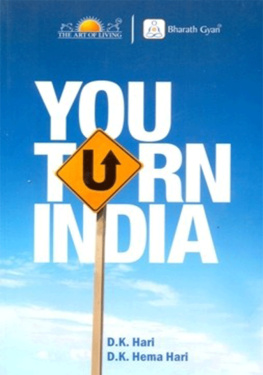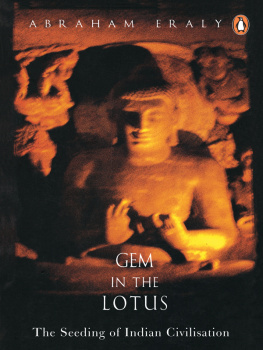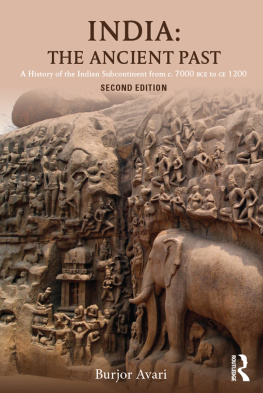India: The Ancient Past
Burjor Avaris balanced and well-researched book is a most reliable guide to the period of Indian history that it covers. It displays considerable mastery of primary and secondary literature and distils it into a wonderfully lucid exposition. This book should be of interest to both lay readers and academic experts.
Lord Bhikhu Parekh, University of Westminster
A clear and systematic introduction to the rich story of the Indian past from early pre-history up until the beginning of the second millennium, this survey provides a fascinating account of the early development of Indian culture and civilisation.
The study covers topics such as the Harappan Civilisation, the rise of Hindu culture, the influx of Islam from the eighth to the twelfth century, and key empires, states and dynasties. Through such topics and their historiographies, the book engages with methodological and controversial issues.
Features of this richly illustrated guide also include a range of maps to illustrate different time periods and geographical regions. Selected source extracts for review and reflection can be found at the end of every chapter, together with questions for discussion.
India: The Ancient Past provides comprehensive coverage of the political, spiritual, cultural and geographical history of India in a uniquely accessible manner that will appeal both to students and to those with a general interest in Indian history.
Burjor Avari was born in India in 1938, spent his childhood in Kenya and Zanzibar, graduated in history at Manchester University and was trained as a teacher at the Oxford University Institute of Education. He taught history in Kenyan and British schools for twenty-two years, from 1962 to 1984; and he gained experience as team leader for developing multicultural education in the schools of the English borough of Tameside from 1984 to 1987. He was appointed in 1988 as Principal Lecturer at the Manchester Metropolitan University, where he now coordinates multicultural education and teaches Indian history (part time). He received an MBE in 1988 in recognition of his work in multicultural education.
India: The Ancient Past
A history of the Indian sub-continent from c. 7000 BC to AD 1200
Burjor Avari

LONDON AND NEW YORK
First published 2007
by Routledge
2 Park Square, Milton Park, Abingdon, Oxon OX14 4RN
Simultaneously published in the USA and Canada
by Routledge
270 Madison Ave, New York, NY 10016
Routledge is an imprint of the Taylor & Francis Group, an informa business
This edition published in the Taylor & Francis e-Library, 2007.
To purchase your own copy of this or any of Taylor & Francis or Routledges collection of thousands of eBooks please go to www.eBookstore.tandf.co.uk.
2007 Burjor Avari
All rights reserved. No part of this book may be reprinted or reproduced or utilised in any form or by any electronic, mechanical, or other means, now known or hereafter invented, including photocopying and recording, or in any information storage or retrieval system, without permission in writing from the publishers.
British Library Cataloguing in Publication Data
A catalogue record for this book is available from the British Library
Library of Congress Cataloging in Publication Data
Avari, Burjor.
India, the ancient past: a history of the Indian sub-continent from c. 7000 BC to AD 1200/Burjor Avari.
p. cm.
Includes bibliographical references and index.
1. IndiaHistoryTo 1500. I. Title.
DS451.A87 2007
934dc22 2006030369
ISBN 0-203-08850-6 Master e-book ISBN
ISBN13: 978-0-203-08850-0 Master e-book ISBN
ISBN13: 978-1-134-25161-2 ePub ISBN
ISBN10: 0-415-35615-6 (hbk)
ISBN10: 0-415-35616-4 (pbk)
ISBN13: 978-0-415-35615-2 (hbk)
ISBN13: 978-0-415-35616-9 (pbk)
Dedicated to the memory of my dear parents, teachers and good friend David Melling
A vision for India
Where the mind is without fear and the head is held high;
Where knowledge is free;
Where the world has not been broken up into fragments by
narrow domestic walls;
Where the clear stream of reason has not lost its way into the
dreary desert sand of dead habit;
Into that heaven of freedom, my Father, let my country awake.
(From Gitanjali, by Rabindranath Tagore,
Nobel Laureate, 1913)
Contents
Extracts
1.1 | The use of hyperbole in praise of India |
1.2 | Sacred geography in the Hindu imagination |
1.3 | The Macaulay Minutes |
1.4 | An example of tampering with historical evidence |
2.1 | The African origins of human beings |
2.2 | Major crop types: native or foreign? |
3.1 | The claim of the Indus Civilisation being a Vedic Civilisation |
3.2 | Mortimer Wheeler as director general of the Archaeological Survey of India |
3.3 | The Great Bath at Mohenjo Daro |
4.1 | Pertinent Sanskrit/Avestan equivalents of some random words |
4.2 | The pre-Aryan legacy |
4.3 | Description of Ayodhya in the Ramayana |
4.4 | Verses from two well-known hymns of the Rig-Veda |
4.5 | An early example of dissent against the idea of Vedic sacrifice |
5.1 | Two accounts of Alexanders conduct at Taxila |
5.2 | Gandhis comment on animal sacrifices |
5.3 | Buddhist emphasis on character rather than birth |
6.1 | The question of dating and authorship of the Arthashastra |
6.2 | European ignorance of non-European geography |
6.3 | The early history of writing in the Indian sub-continent |
7.1 | Wealth and morality as explained in the Naradasmriti |
7.2 | Four millennia of musical ancestry |
7.3 | Some simple advice regarding personal health |
7.4 | The Amaravati sculptures |
8.1 | The Mandasor inscription of the silk-weavers |
8.2 | A problem attributed to Aryabhata by Bhaskara I |
8.3 | Doubts about the extent of influence of Indian fables on European literature |
9.1 | Agricultural innovations in the Tamil country |
9.2 | An example of Shiva bhakti in Tamil religious literature |
9.3 | Harshas signature |
10.1 | The promotion of scholarship and scholarly exchanges |
10.2 | The idea of debate in the Nyaya tradition |
10.3 | The imperfections of Sanskrit |
10.4 | The status of the Mapillas |










